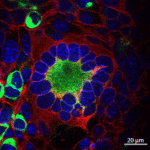Lien vers Pubmed [PMID] – 24116202
PLoS ONE 2013;8(10):e77072
Simian foamy viruses (SFV) are widespread retroviruses among non-human primates (NHP). SFV actively replicate in the oral cavity and can be transmitted to humans through NHP bites, giving rise to a persistent infection. We aimed at studying the natural history of SFV infection in human. We have analyzed viral load and gene expression in 14 hunters from Cameroon previously shown to be infected with a gorilla SFV strain. Viral DNA could be detected by quantitative polymerase chain reaction (q-PCR) targeting the pol-in region, in most samples of peripheral blood mononuclear cells (PBMCs) (7.1 ± 6.0 SFV DNA copies/105 PBMCs) and saliva (2.4 ± 4.3 SFV DNA copies/105 cells) derived from the hunters. However, quantitative real-time reverse-transcription polymerase chain reaction (RT)-qPCR revealed the absence of SFV viral gene expression in both PBMCs and saliva, suggesting that SFV was latent in the human samples. Our study demonstrates that a latent infection can occur in humans and persist for years, both in PBMCs and saliva. Such a scenario may contribute to the putative lack of secondary human-to-human transmissions of SFV.


